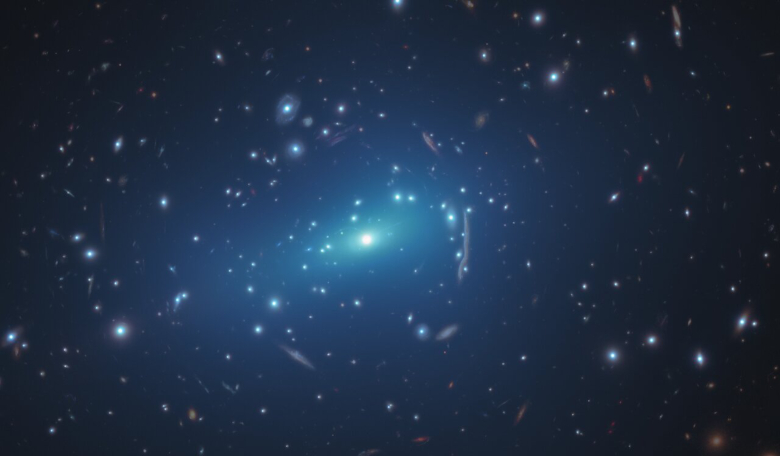The term dark matter has been bandied about for decades now and while many studies are devoted to understanding more about this elusive substance, it is fair to say, that not a great deal is really known about it. What understanding there is about this mysterious matter is now under question as new data from Hubble has found pockets of the stuff producing effects that are 10 times stronger than expected.
Dark matter is estimated to constitute 84.5 percent of the total matter in the universe and yet because it neither emits nor absorbs light or other electromagnetic radiation at any significant level, searches for it still remain futile.
Scientists are sure it is there though, because galaxies need vast amounts of gravity, which is generated from matter, to stop themselves from tearing apart.
Trouble is, the visible matter we can see in galaxies strewn throughout the cosmos is not nearly enough. Something unseen must therefore be holding them together by giving these galaxies extra mass. But the true nature of what that something is, still remains a mystery.
Aiding in the investigations into this secretive substance are galaxy clusters. These enormous structures that are made-up of many individual galaxies, are thought to be the largest repository of dark matter and scientists have been using them to compare numerical simulations of the Universe with observations of gravitational lensing.
Gravitational lensing is a phenomena astronomers use to see distant background objects where something in the foreground is blocking the view.
They can do this because thanks to the general theory of relativity, we know that mass bends light. Einstein showed that any massive celestial object can bend passing light rays in the same way that a glass lens bends light in a microscope or telescope.
Scientists take advantage of this gravitational lensing effect to map the distribution of dark matter in clusters; the higher the concentration of dark matter in a cluster, the more dramatic its light-bending effect.
However a recent investigation into three key galaxy clusters, MACS J1206.2-0847, MACS J0416.1-2403 and Abell S1063, using gravitational lensing has thrown up something unusual.
Using data from the Hubble telescope on these three clusters, a team of astronomers found to their surprise a number of unexpected features nested near each cluster's core, where the most massive galaxies reside.
Because a higher concentration of dark matter in a cluster gives a more dramatic light-bending effect, the team surmised that the presence of the nested lenses were being produced by the gravity of dense pockets of dark matter inside the individual cluster galaxies that had magnified and warped the passing light.
To check their findings, the team followed up with additional spectroscopic data from the European Southern Observatory’s Very Large Telescope (VLT) in Chile and were able to identify dozens of multiply imaged, lensed, background galaxies; multiple images of the same distant galaxy is another feature of gravitational lensing.
"The data from Hubble and the VLT provided excellent synergy," says team member Piero Rosati of the Università degli Studi di Ferrara in Italy, who led the spectroscopic campaign. "We were able to associate the galaxies with each cluster and estimate their distances."
In order to discern visible matter from dark matter, the team then measured the velocity of the stars orbiting inside several of the cluster galaxies to get an estimate of each individual galaxy's mass.
The resulting complementary analysis allowed the team to assemble a well-calibrated, high-resolution map of the mass distribution of dark matter in each cluster.
So far so good, as the team’s theory was stacking up. The final process was to compare the dark-matter maps with simulated models of galaxy clusters with similar masses at roughly the same distances.
"Galaxy clusters are ideal laboratories in which to study whether the numerical simulations of the Universe that are currently available reproduce well what we can infer from gravitational lensing," said Massimo Meneghetti of the INAF-Observatory of Astrophysics and Space Science of Bologna in Italy, the study's lead author.
This though did not turn out as anticipated as the clusters in the computer model did not tally with any of the same level of dark-matter concentration on the smallest scales seen in the Hubble images.
"We have done a lot of testing of the data in this study, and we are sure that this mismatch indicates that some physical ingredient is missing either from the simulations or from our understanding of the nature of dark matter," added Meneghetti.
The missing ingredient is still that - missing, and with our (limited) understanding of dark matter now under scrutiny, is it back to the drawing board? The short answer to that is yes.
"To me personally, detecting a gnawing gap - a factor of 10 discrepancy in this case - between an observation and theoretical prediction is very exciting,”said Priyamvada Natarajan of Yale University, a senior theorist on the team who has mapped dark matter before.
"This could signal a gap in our current understanding of the nature of dark matter and its properties, as these exquisite data have permitted us to probe the detailed distribution of dark matter on the smallest scales."
The team’s research is published in today’s issue of the journal Science.











